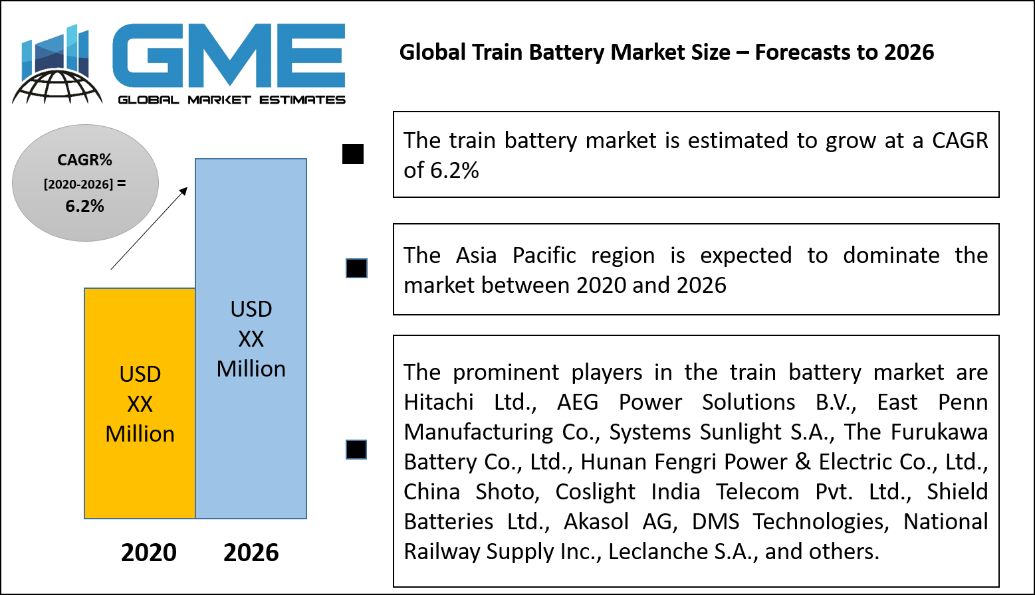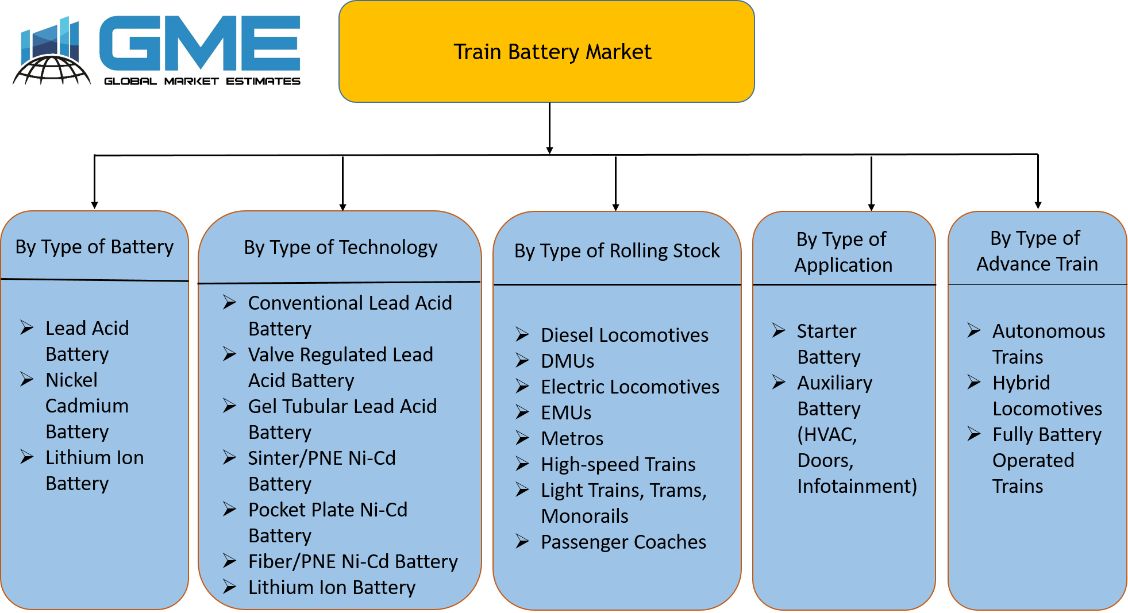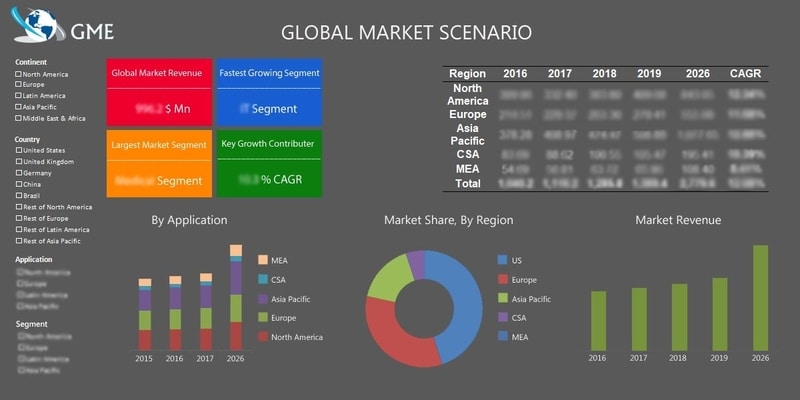
Train Battery Market Size, Trends & Analysis with COVID-19 Impact - Forecasts to 2026 By Type of Battery (Lead Acid Battery, Nickel Cadmium Battery, and Lithium-Ion Battery) By Type of Technology (Conventional Lead Acid Battery, Valve Regulated Lead Acid Battery, Gel Tubular Lead Acid Battery, Sinter/PNE Ni-Cd Battery, Pocket Plate Ni-Cd Battery, Fiber/PNE Ni-Cd Battery, and Lithium-Ion Battery), By Type of Rolling Stock (Diesel Locomotives, DMUs, Electric Locomotives, EMUs, Metros, High-speed Trains, Light Trains, Trams, Monorails, and Passenger Coaches), By Type of Application (Starter Battery and Auxiliary Battery [HVAC, Doors, Infotainment]), By Type of Advance Train (Autonomous Trains, Hybrid Locomotives, and Fully Battery Operated Trains), By Type of Region (NA [North America], Europe, APAC [Asia Pacific], MEA [the Middle East & Africa], and CSA [Central & South America]), End-User Landscape, Vendor Landscape, Company Market Share Analysis & Competitor Analysis
Train Battery Market Insights
The train battery market is penetrated to classify the excelling amplification of CAGR 6.2% during the estimated period (2020-2026). Train battery is the technological up-gradation of coal furnaces employed in steam engines. The trains are powered by storage-based batteries which render to multiple purposes such as high energy efficiency, economical maintenance cost, lesser labor requirement, and faster passenger mobility compared to conventional train engines using fuel-based operations. With the inopportune consequences of the COVID-19, various sectors had to shut down and suffered unendurable losses disabling the growth of the industries as well as the economy of several nations. But, transportation especially, railways were functioning at half the capacity to deliver essential goods from one place to another rendering to people's services. It is safer to evaluate that the global train battery market will see a radical acceleration in the advancing times. Increase in greenhouse gas emissions, the surge in swift commutation, and adaptation of high-speed trains, climb in urbanization are a few of various inferences that concludes to notice a hastening of the market during the period.

Train Battery Market: By Type of Battery
The multiple categories of train batteries are lead nickel, cadmium acid, and lithium-ion battery. Lithium-ion batteries are assumed to notice a flitting increase in the period (2020-2026). With high density, Lithium-ion batteries are rechargeable in nature. The applications can be noticed in compact electronic devices commonly utilized in the aerospace and transportation areas. The chauffeurs of the market can be discerned as cost-effectivity, increase in pollutants, and increase in adoption for high-speed trains in countries like China, India, and others.
Train Battery Market: By Type of Technology
Based on technologies used in the global market are sinter/PNE Ni-Cd, pocket plate Ni-Cd, conventional lead-acid, gel tubular lead-acid, fiber/PNE Ni-Cd, valve regulated lead-acid, and lithium-ion batteries. Sinter/PNE Ni-Cd battery is estimated to stretch in the forecast period. Extension of automotive manufacturing industries, increasing energy density, easy maintenance, operation & portability plays as a factor promoting the growth of the market onward.
Train Battery Market: By Type of Rolling Stock
Based on the types of rolling stock, the market can be segregated as DMUs, diesel locomotives, electric locomotives, metros, EMUs, high-speed trains, trams, light trains, passenger coaches and monorails. The category to wax in the succeeding years would be high-speed trains, an increase in urbanization, adoption of advanced technology, diminishing fossil fuel resources are few of the many drivers drafting the growth of the market.
Train Battery Market: By Type of Application
Starter and auxiliary battery (Doors, HVAC, and Infotainment) are the central applications of the market where the auxiliary battery is pitched to generate the highest share in CAGR. The factors affecting the market are the expansion of railway networks, high need for high-level innovations such as automated doors, and an increase in urbanization.

Train Battery Market: By Type of Advance Train
Advance trains in the sector of the train battery market are hybrid locomotives, autonomous, and fully battery-operated trains. The segment which is rated to be prevalent in the following years is fully battery-operated trains. The determinants torquing the global market are the universality for storage batteries, the great application of UPS [Uninterrupted Power Supply], the surge in automotive components production industries, and lower cost maintenance.

Train Battery Market: By Region
NA (North America), APAC (Asia-Pacific), Europe, MEA (the Middle East & Africa), and CSA (Central & South America) are the regions based on the regional breakdown. APAC is inspected to aviate amongst other regions due to the attributes such as nations like India having the largest rail network, the process of induction of bullet trains in several states of India, administration initiatives to advertise energy-efficient transportation solutions are some of the boosters of the market.
Train Battery Market Share and Competitor Analysis
The prominent players in the train battery market are Hitachi Ltd., AEG Power Solutions B.V., East Penn Manufacturing Co., Systems Sunlight S.A., The Furukawa Battery Co., Ltd., Hunan Fengri Power & Electric Co., Ltd., China Shoto, Coslight India Telecom Pvt. Ltd., Shield Batteries Ltd., Akasol AG, DMS Technologies, National Railway Supply Inc., Leclanche S.A., and others.
Please note: This is not an exhaustive list of companies profiled in the report.
In June 2019, EnerSys announced strategies to extend its Thin Plate Pure Lead (TPPL) capacity over the next three years with an additional capacity of $100 million spending’s besides an anticipated 15% jump from the constant focus on meager principles.
In April 2019, Saft Batteries obtained a huge shipment from MRS Logistica S.A., one of the major logistics companies in Brazil, provide customized SRX on-board battery systems.
Check the Press Release on Train Battery Market Report
We value your investment and offer free customization with every report to fulfil your exact research needs.
The Train Battery Market has been studied from the year 2017 till 2026. However, the CAGR provided in the report is from the year 2018 to 2026. The research methodology involved three stages: Desk research, Primary research, and Analysis & Output from the entire research process.

The desk research involved a robust background study which meant referring to paid and unpaid databases to understand the market dynamics; mapping contracts from press releases; identifying the key players in the market, studying their product portfolio, competition level, annual reports/SEC filings & investor presentations; and learning the demand and supply side analysis for the Train Battery Market

The primary research activity included telephonic conversations with more than 50 tier 1 industry consultants, distributors, and end-use product manufacturers.

Finally, based on the above thorough research process, an in-depth analysis was carried out considering the following aspects: market attractiveness, current & future market trends, market share analysis, SWOT analysis of the companies and customer analytics.

Tailor made solutions just for you
80% of our clients seek made-to-order reports. How do you want us to tailor yours?
OUR CLIENTS